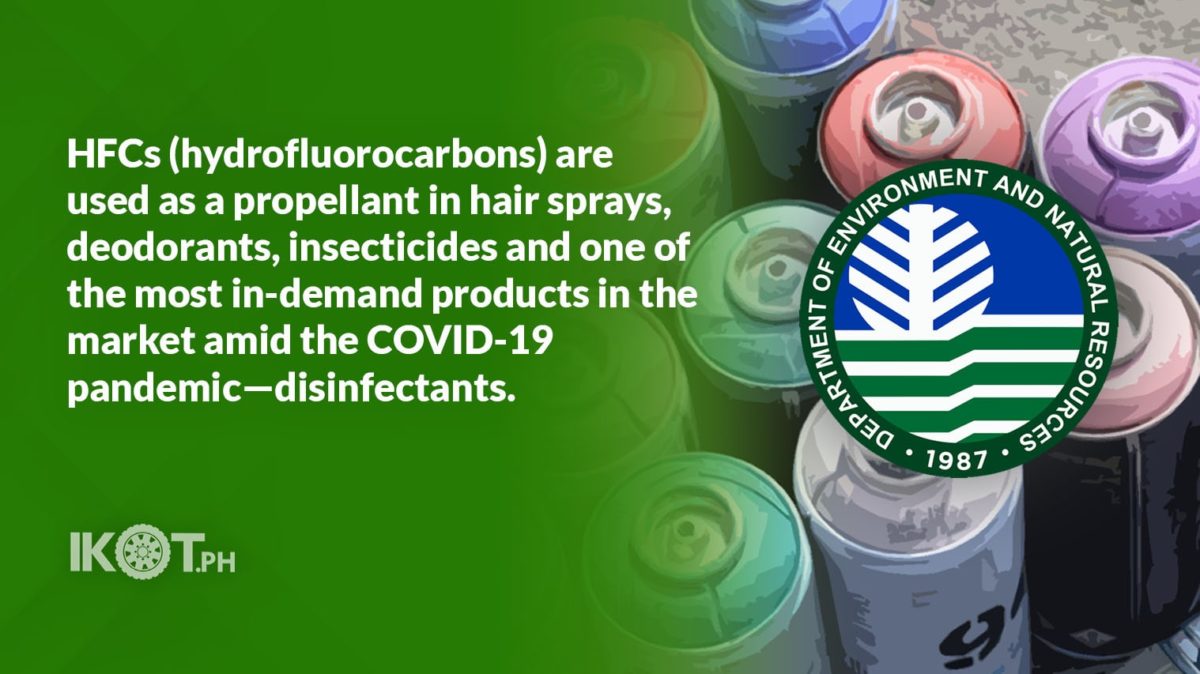Environment Secretary Roy Cimatu is urging Filipino consumers to avoid using household products containing hydrofluorocarbons (HFCs), which are considered the fastest growing greenhouse gases (GHG) that contribute significantly to climate change.
HFCs are used as a propellant in hair sprays, deodorants, insecticides and one of the most in-demand products in the market amid the COVID-19 pandemic—disinfectants.
“By choosing not to buy products containing HFCs, consumers will be reducing GHG levels and sending a message to companies not to continue to use the propellant in their products.”
“By choosing not to buy products containing HFCs, consumers will be reducing GHG levels and sending a message to companies not to continue to use the propellant in their products,” Cimatu said.
The environment chief issued the statement in support of the awareness-raising efforts of the DENR’s Environmental Management Bureau, through the Philippine Ozone Desk (POD).
POD facilitates and coordinates projects and policies on the phaseout of ozone-depleting substances (ODS) pursuant to the country’s commitment to the Montreal Protocol on Substances that Deplete the Ozone Layer and the Kigali Amendment to the Montreal Protocol.
The Kigali Amendment is an international agreement to gradually reduce the consumption and production of HFCs, which replaced the ozone-destroying chlorofluorocarbons (CFCs) previously used in air conditioners and refrigerants.
However, HFCs were later found to be powerful GHG that can be hundreds to thousands of times more potent than carbon dioxide in contributing to climate change per unit of mass.
“While most of the aerosols available in the market today are free from ODS, some products still use the alternative HFCs which contribute to global warming.”
In a recent webinar organized by POD, its public awareness officer, Joylan Nephi Babia, said that while most of the aerosols available in the market today are free from ODS, some products still use the alternative HFCs which contribute to global warming.
Babia warned that HFCs have “high or very high” global warming potentials ranging from 12 to 14,800.
Babia cited in particular HFC 134a used as propellant in disinfectant sprays, which has a “global warming potential of 1,300 on a 100-year time scale.”
“While HFCs are not ODS, HFCs are known to aggravate global warming,” Babia said urging consumers to look closely at the labels of disinfectant sprays they will buy, and “as much as possible, use these products sparingly.”
He also advised consumers to use instead disinfectant sprays that use either LPG or hydrocarbons such as propane, butane, and isobutane as a propellant, saying these are more environment-friendly having low global warming potentials.
Since HFCs are vital alternatives to CFCs, they cannot be removed from the market immediately.
HFCs were developed after the phaseout of CFCs and hydrochlorofluorocarbons (HCFCs) required by the Montreal Protocol in 1987.
The climate benefit of reducing HFC emissions has been widely recognized, leading to an amendment of the Montreal Protocol, known as the Kigali Amendment, calling for developed countries to start to phase down HFCs by 2019 and in developing countries to follow with a freeze between 2024 and 2028.
The Philippines is currently focused on phasing out the supposed last batch or group of ODS—the HCFCs—which phaseout schedule spans for 27 years from 2013 to 2040.

